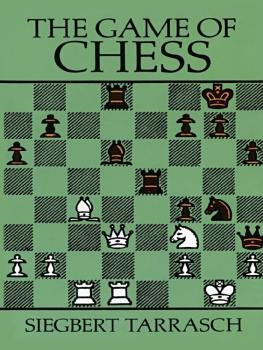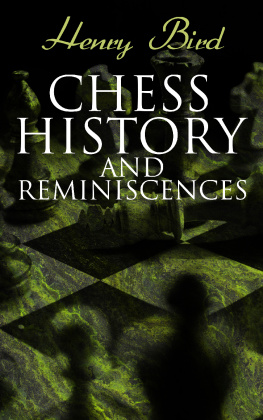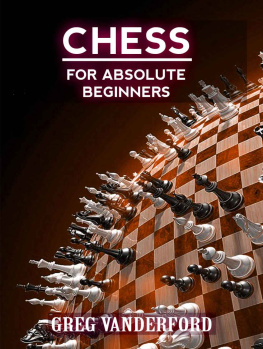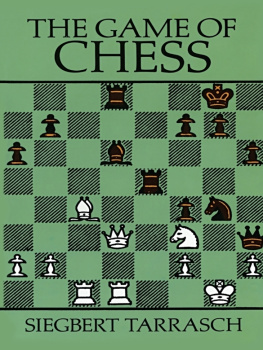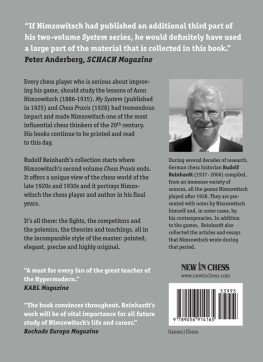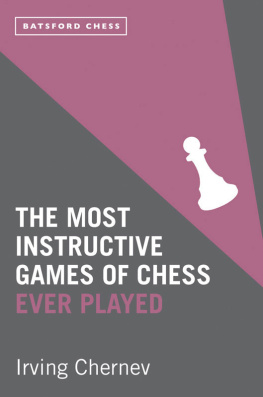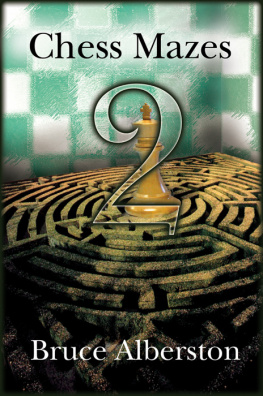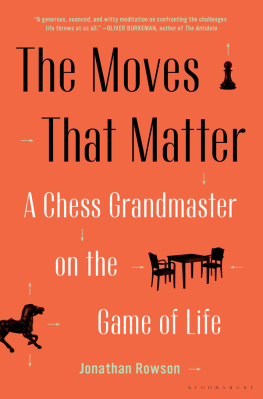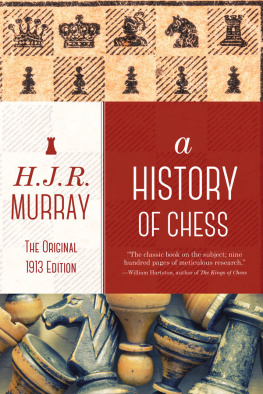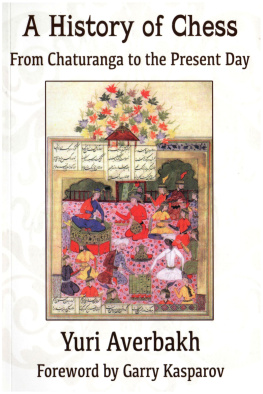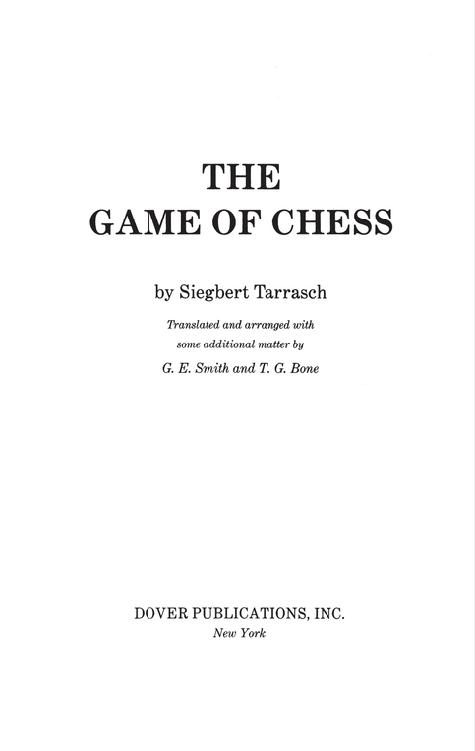This Dover edition, first published in 1987, is an unabridged and unaltered republication of The Game of Chess; A Systematic Text-Book for Beginners and More Experienced Players , originally published by David McKay Company, Philadelphia, in 1935.
Library of Congress Cataloging-in-Publication Data
Tarrasch, Siegbert, 1862 1934.
The game of chess.
Reprint. Originally published: Philadelphia : D. McKay Co., 1935.
1. Chess. I. Title.
GV1445.T2413 1987 794.12
87 9146
9780486144559
Manufactured in the United States by Courier Corporation
25447X08
www.doverpublications.com
THE ENGLISH EDITION OF THIS WORK IS
DEDICATED TO MY GOOD FRIEND
MR. G. E. SMITH
CHESS EDITOR OF THE FIELD
NOTE TO ENGLISH EDITION
A LTHOUGH the name of Tarrasch is well known to the vast majority of serious chess players all over the world, there may be some readers of this book who have never heard of him, his fine record as a player and his great services to chess and chess players as a writer. A short summary of his career may, therefore, not be out of place.
Siegbert Tarrasch was born at Breslau on March 5, 1862. At the age of eighteen he commenced the study of medicine. After obtaining his degree he practised for a short time at Geroldsgrn, then for many years at Nuremburg and later at Munich. He learnt to play chess at an early age and made very rapid progress. His first appearance in an international masters tournament was in 1885 at Hamburg (where he tied with four other players for the second place), his last in 1928 at Berlin (where an illness compelled his retirement after the third round). During his long career he won no fewer than seven international tournaments, two of them without the loss of a game. In matches he defeated Walbrodt (Germany), Marshall (U.S.A.) and Mieses (Germany)all by wide margins and drew with Tchigorin (Russia) and Schlechter (Austria). Unfortunately the greatest triumphthe Worlds Championshipwas denied him, for in 1908 he was defeated in a match by the then champion Dr. Lasker. The last years of his life were devoted to literary work on the game. He died at Munich on February 17, 1934.

It is strange that, although Dr. Tarrasch, the Praeceptor Germaniae as he was called, was a prolific writer on the game and his works were universally acknowledged to be of very great instructional value, it has been left to his last book, Das Schachspiel , published in 1931, to be the first to appear in an English edition. This book has had a really phenomenal success of which Dr. Tarrasch was justly proud and he was delighted at the prospect of it being translated into English. Our great regret is that he has not lived to see this edition.
In a letter written about a month before his death Dr. Tarrasch announced his intention of making in the section on the Openings various slight alterations and additions, the results of his untiring analytical investigations during the last three years. However, in the time that elapsed between his announcing this intention and his sudden death he had, apparently, not been able to start on the work of writing down this new matter, for a diligent search among his papers revealed nothing on the subject. Thus we were faced with the alternatives of presenting a translation of the book as it stood or of incorporating in it such additional matter on the Openings as Dr. Tarrasch had published in the magazine Tarraschs Schachzeitung which he ran for the last eighteen months of his life. We decided on the latter course.
In incorporating this additional matter we have restricted ourselves to the additions and, in a few cases, alterations to lines of play already dealt with in Das Schachspiel. Exceptions have been made in the cases of (1) the now popular defence to the Ruy Lopez by 3.... P QR3 and 4.... P Q3 and (2) the attack against the Caro-Kann Defence by 2. P Q4, 3. P P and 4. P QB4. We should mention, too, that the wording of the additional matter has occasionally been slightly condensed, but the reader may rest assured that nothing of importance has been omitted.
A few slight alterations, due to the different notations used in England and Germany, have had to be made in the section on the Elements. Naturally, the description of the board has had to be modified.
Finally, five more games have been included in this edition, thus bringing the number up to twelve. Of these games Nos. 8, 9 and 10 have been taken from Tarraschs Schachzeitung and Nos. 11 and 12 from Dr. Tarraschs book Die moderne Schachpartie. The notes are in every case his own.
G. E. S.
T. G. B.
AUTHORS PREFACE
E VERY chess player will readily agree that chess, that wonderful gift from the East, is not only the noblest and finest of all games but, standing, as it does, on the borderline between game, art and science, is undoubtedly one of the greatest intellectual delights. It has only one disadvantageit is very difficult to learn. That disadvantage I hope to have removed by this book.
There would be little point in adding yet another to the many text-books if this one were merely developed according to the same scheme as the others. There is, however, something completely new in my method of teaching the Elements and the Middle Game. I maintain that nobody completely ignorant of chess could understand it from a study of any of the text-books we have at present and simply because the method they employ to teach the Elements is as faulty as if, to teach a child to talk, one were to deliver a lecture on the grammatical structure of the German language. I employ quite another method and one analogous to that a mother uses to teach her child to talk. I play with the beginner from the very start in that I put before him simple positions and from them explain the fundamentals of chess. It is the intuitive method of instruction. In this way the pupil learns chess quite easily, of that I am convinced. He learns by playing and during the play I am continually advancing from the simple to the difficult and helping him to acquire chess vision.
In subsequent sections, also, my classification and treatment of the material is quite new. The other manuals, after dealing with the Elements, treat of the various openings, explaining each of them from actual games. They then proceed to the End-Game. I reverse the order. I begin with the End-Game since obviously it is easier for the beginner to deal with a few men than with the entire thirty-two. Here again, I introduce much that is new. (For example, I have explained so simply and clearly the very difficult End-Game of King, Bishop and Knight v. King that it can now easily be mastered by everybody.) On the other hand, I have omitted all those End-Games which do not occur in actual play.
After the End-Game I have a section dealing with the Middle Game, the most important part of the game. (This other manuals have omitted because the way to teach the Middle Game was not known.) Here I trace back to fixed and constantly recurring types the manifold combinations of chess and in this way, by giving numerous examples, I endeavour to teach the beginner combination play. This section I have called Typical Middle-game Combinations and Attacks. It is the most exhaustive and most important of the book, and, as also the subsequent sections, will prove a very profitable study even for experienced players.
Finally I come to the most difficult part of the gamethe Opening. I start with a general chapter, The General Theory of the Opening, in which I present an entirely new and original Theory of chess. (This up to now has never been done; what has hitherto been understood in chess circles as Theory is, in reality, quite different, nothing more nor less than Practice!!) This chapter is followed by The Various Openings, which deals with the important lines of practically all the openings. Naturally, it does not set out to be exhaustive.

